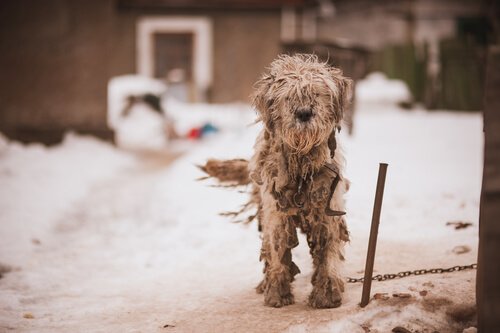Types of Concealed Animal Cruelty

Whenever you hear about animal cruelty, it’s more clear that you already know what that phrase means, but it goes beyond hitting or abandoning a dog. There are certain types of concealed animal cruelty that can go unnoticed by the law and the people around you.
Concealed animal cruelty
It’s obvious that you will have the urge to immediately call the police on anyone who is hitting or mistreating an animal. However, some people treat their dogs in a certain way that goes unnoticed. Here are some of the most common ways:
Humanizing them
The abuse that’s normally seen by people is often is an act of brutality, but it’s different in the case of concealed animal cruelty. Sometimes people abuse their pets because of the strong love they have for them. For example, some people humanize them without realizing it.
They begin to talk to them as if they were people, and give them a place on their couch or bed. They bathe them every day and make them wear fresh, fashionable clothes in the summer and warm ones in winter. In short, they forget that dogs are not people, but animals.
This is a form of cruelty because the animal has to hold their instincts and they aren’t allowed to unleash their personality. In other words, instead of letting them be themselves, the pets have to adapt perfectly to the lifestyle of the person who is humanizing them.
Consequently, this creates a stressed, fearful pet. They might even become antisocial and have anxiety disorders because they don’t know how to handle this problematic situation.
Abandonment in the home
Animal cruelty goes beyond abandonment in the streets. For example, leaving an animal home alone for more than eight hours a day can be cruel. It’s worse if the pet is outdoors or locked up in a room.

Dogs are social animals that need receive and give company and affection to others. Being alone longer than necessary is another form of cruelty. If at any time you see or suspect a situation like this one, report it to the relevant authorities.
Not providing the necessary care
Many people mistakenly believe that putting a roof over an abandoned animal is enough for its well-being. Nothing could be farther from the truth. Animals need food, hygiene, exercise, affection, and tranquility.
We’ve already discussed “Noah syndrome” on one occasion, which is a psychological disorder that causes people to hoard animals in their homes and then not provide them with basic care. This is another form of cruelty that’s punishable by law. Also, it’s not good for animals or their rights at all.
In the case of Noah syndrome, unsanitary conditions occur that can affect people nearby. Although you might not know anyone with this syndrome, you might know someone with just one animal who doesn’t care for it properly, which is also cruelty.
Forced labor
Who hasn’t been to a circus whey they were a child? Do you remember getting entertained by the lions and elephants? Today, some people enjoy an elephant ride in Thailand or a camel ride in Morocco. However, have you ever thought about the conditions these animals live in? In most cases, they are victims of animal cruelty.

These animals are often abused, they spend several hours outdoors in extreme temperatures just so their owner can get a quick buck out of it. There was a real case of an elephant who actually teared up and cried after being released from the chains that kept him prisoner for decades. What a sad reality!
You as an animal lover should keep an eye out for any sign of concealed animal cruelty. It’s everyone’s duty to look out for the well-being and rights of animals. Don’t be a coward — be brave and report any time you witness animal cruelty!
Whenever you hear about animal cruelty, it’s more clear that you already know what that phrase means, but it goes beyond hitting or abandoning a dog. There are certain types of concealed animal cruelty that can go unnoticed by the law and the people around you.
Concealed animal cruelty
It’s obvious that you will have the urge to immediately call the police on anyone who is hitting or mistreating an animal. However, some people treat their dogs in a certain way that goes unnoticed. Here are some of the most common ways:
Humanizing them
The abuse that’s normally seen by people is often is an act of brutality, but it’s different in the case of concealed animal cruelty. Sometimes people abuse their pets because of the strong love they have for them. For example, some people humanize them without realizing it.
They begin to talk to them as if they were people, and give them a place on their couch or bed. They bathe them every day and make them wear fresh, fashionable clothes in the summer and warm ones in winter. In short, they forget that dogs are not people, but animals.
This is a form of cruelty because the animal has to hold their instincts and they aren’t allowed to unleash their personality. In other words, instead of letting them be themselves, the pets have to adapt perfectly to the lifestyle of the person who is humanizing them.
Consequently, this creates a stressed, fearful pet. They might even become antisocial and have anxiety disorders because they don’t know how to handle this problematic situation.
Abandonment in the home
Animal cruelty goes beyond abandonment in the streets. For example, leaving an animal home alone for more than eight hours a day can be cruel. It’s worse if the pet is outdoors or locked up in a room.

Dogs are social animals that need receive and give company and affection to others. Being alone longer than necessary is another form of cruelty. If at any time you see or suspect a situation like this one, report it to the relevant authorities.
Not providing the necessary care
Many people mistakenly believe that putting a roof over an abandoned animal is enough for its well-being. Nothing could be farther from the truth. Animals need food, hygiene, exercise, affection, and tranquility.
We’ve already discussed “Noah syndrome” on one occasion, which is a psychological disorder that causes people to hoard animals in their homes and then not provide them with basic care. This is another form of cruelty that’s punishable by law. Also, it’s not good for animals or their rights at all.
In the case of Noah syndrome, unsanitary conditions occur that can affect people nearby. Although you might not know anyone with this syndrome, you might know someone with just one animal who doesn’t care for it properly, which is also cruelty.
Forced labor
Who hasn’t been to a circus whey they were a child? Do you remember getting entertained by the lions and elephants? Today, some people enjoy an elephant ride in Thailand or a camel ride in Morocco. However, have you ever thought about the conditions these animals live in? In most cases, they are victims of animal cruelty.

These animals are often abused, they spend several hours outdoors in extreme temperatures just so their owner can get a quick buck out of it. There was a real case of an elephant who actually teared up and cried after being released from the chains that kept him prisoner for decades. What a sad reality!
You as an animal lover should keep an eye out for any sign of concealed animal cruelty. It’s everyone’s duty to look out for the well-being and rights of animals. Don’t be a coward — be brave and report any time you witness animal cruelty!
All cited sources were thoroughly reviewed by our team to ensure their quality, reliability, currency, and validity. The bibliography of this article was considered reliable and of academic or scientific accuracy.
- Cedón, M. & Holm, A. (2012) ABANDONO DE ANIMALES DE COMPAÑÍA. Universidad Autónoma de Barcelona.
This text is provided for informational purposes only and does not replace consultation with a professional. If in doubt, consult your specialist.








